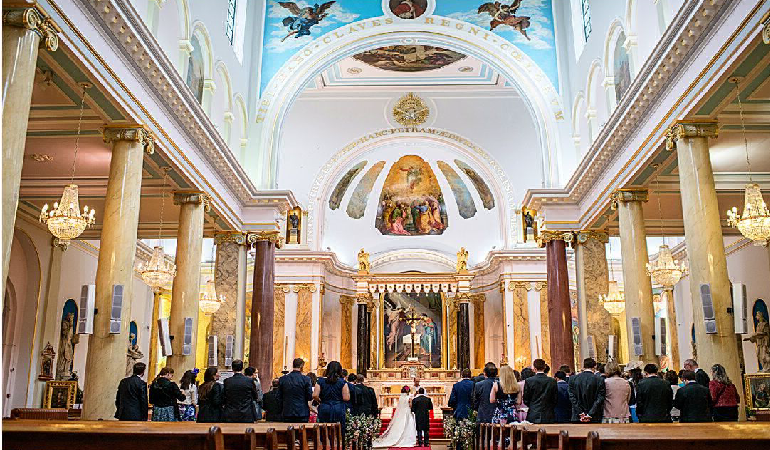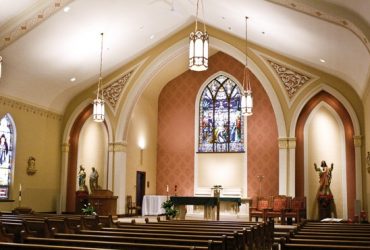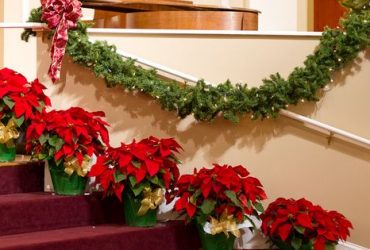St. Peter’s Italian Church: The History
One-Hundred Year History of a Family of Believers
To celebrate 100 years in the history of a church is to celebrate 100 years in the life of a family of believers.
What makes up a church is not so much the walls of a building, but the people who built that church, rebuilt it when destroyed, defended it from extinction and made it a living and vibrant place of worship through the generations.
To celebrate 100 years of a church means that the members of a community rediscover that they are spiritually united with the people that built it and kept it alive through the years until the present day. It means that we, living today in 2004, feel ONE FAMILY OF BELIEVERS with those who went before us.
 To celebrate 100 years of St. Peter’s Church is to celebrate our family history. Though scattered far and wide in Southern California and beyond, we form one family of believers with intimate and sacred ties to the Church of St. Peter, where our ancestors were welcomed into the faith through baptism, had their marriages blessed and from where they were buried. And today, in the same church, we still baptize our children, have the weddings of our sons and daughters blessed, and we give our last farewell in the Lord to our departed. This is the church where we still gather in special moments to honor and celebrate our patron saints, carrying their images in solemn procession, to express our common faith.
To celebrate 100 years of St. Peter’s Church is to celebrate our family history. Though scattered far and wide in Southern California and beyond, we form one family of believers with intimate and sacred ties to the Church of St. Peter, where our ancestors were welcomed into the faith through baptism, had their marriages blessed and from where they were buried. And today, in the same church, we still baptize our children, have the weddings of our sons and daughters blessed, and we give our last farewell in the Lord to our departed. This is the church where we still gather in special moments to honor and celebrate our patron saints, carrying their images in solemn procession, to express our common faith.
Through this centennial celebration, we rediscover our identity and rededicate ourselves to maintain alive and strong the faith of our fathers.
* * *
If you drive along Alameda Avenue between downtown and Lincoln Heights and you turn your head (left if you travel north, right if you travel south) you have a striking, unobstructed view of St. Peter’s Church.
I was driving northbound along such route one late afternoon not long ago and almost distractedly looked to my left. There, across the open expanse that used to be the railroad yard, against the dark backdrop of Chavez Ravine Hill and in the glowing sky of a setting sun, stood our church, in its unmistakable half classical, half California mission style.
The isolated pale green structure appeared minuscule compared to the big skyscrapers of the downtown area I had left behind. Yet its vision reminded me of the great role it played and still plays in the life of our Italian and Italian American community. For one hundred years, it stood as a rallying point for thousand of believers, it united them in the same faith, it comforted them in their struggles, it rejoiced with them and helped them along and blessed their work. Though small in size, it is great in spirit and fertile in spiritual achievements. It has united the Italian and Italian American community as no other entity has. It has preserved the faith and spiritual traditions of its people and led them to prominent and noble accomplishments.
LONG LIVE ST. PETER’S CHURCH!
The Early Years
St. Peter’s Church was set up as a mission church for the spiritual assistance of the Italian people in the spring of 1904 by Bishop Conaty.
 The years between 1890 and 1910 witnessed the greatest mass migration of Italians to the United States. While most migrants settled in the Eastern and Midwestern States, many moved west, to California in particular.
The years between 1890 and 1910 witnessed the greatest mass migration of Italians to the United States. While most migrants settled in the Eastern and Midwestern States, many moved west, to California in particular.
Following the example of many Catholic Bishops on the Eastern coast, Bishop Conaty of Los Angeles, responded to the pastoral needs of the new migrants by establishing a church specifically for them, “to produce good Catholics according to Italian tradition,” as he himself wrote in the document for the construction of St. Peter’s Church.
The first church was a temporary frame structure built on North Spring Street. Father Tito Piacentini was the first pastor. The parish books tell us that the first couple to be wed in the new church were Domenico Pagliassotti and Maddalena Aiasso on August 30, 1904, and the first child to be baptized was Antonio Zaro on September 4, 1904.
Already in those years, however, the center of “Little Italy” was moving more towards the area of North Broadway and North Hill Street. A new location for the church was thought to be more convenient in order to serve the community. The choice fell on a large cemetery chapel along North Broadway which had been built as a memorial for a wealthy person, Andrew Briswalter, who had died in 1885.
This cemetery chapel was dedicated and named St. Peter’s Church on July 4, 1915 during the pastorship of Father A. Bucci, who had succeeded Father Piacentini in 1906 and was pastor until 1918. It served as the parish church for the Italian community until it was destroyed by fire on June 13, 1944.
This early period of St. Peter’s Church was characterized by a succession of many priests at the helm of the church, most of them serving only a couple of years or at most three years (there was also a period, 1926-1930, when the church had no titular pastor, but was served variously by priests of the local Salesian community). The exception was Father A. Bucci, who was pastor for 12 years. Some of the oldest members of the community still remember him. After he left St. Peter, he continued his private ministry elsewhere for many years….
The Building of a New Church
When Bishop Conaty established St. Peter’s Church in 1904, he wanted it to be the church for all Italians in the Archdiocese. In technical terms that came to be used later on, it was to be a “national ethnic parish.” And in fact, although it was originally located in an area that was known as “Little Italy” because largely populated by Italian migrants, Italians from all over Los Angeles considered it their church for worship and for communal celebrations.
 The Italians who settled in Los Angeles had migrated from the various regions of Italy: large contingents came from Piemonte in the north, from Lucca in Tuscany, from Ischia in Campania, from Bari in Puglia and from various provinces in Sicily.
The Italians who settled in Los Angeles had migrated from the various regions of Italy: large contingents came from Piemonte in the north, from Lucca in Tuscany, from Ischia in Campania, from Bari in Puglia and from various provinces in Sicily.
However, it soon became apparent that the largest regional group was made up of Pugliesi. Moreover, the migrants from Puglia, much more than other regional groups, brought with them a staunch attachment to the patron saints of their hometown; such as, San Vittoriano, San Trifone, Madonna di Costantinopoli, Madonna della Stella, San Giorgio, etc., as well as local religious traditions that they wanted to maintain even in the new land.
The Pugliesi soon found their rallying point around St. Peter’s Church and became, as it were, the backbone of the parish organizational life.
* * *
The early life of the Italian church was not an easy one; it went through rather difficult and rough times.
One obvious difficult situation was the already mentioned fact that the priests serving the community had very brief assignments. With many pastors following one after the other, it was difficult to establish a continuity of programs. Many Italians felt disenchanted.
Moreover, already in the late 1930s and early 1940s, the Italian population of the so called Little Italy began to dwindle, as many families moved away from North Broadway to Lincoln Heights, Glassell Park, El Sereno, Alhambra and Monterey Park. To attend St. Peter’s Church they had to come from farther away. For many of them it was easier to go to mass in other churches that were closer.
 A change for the better came about with the appointment as church pastor of Father Michael Cecere in 1943, just a few months after his ordination to the priesthood in the Claritian Order.
A change for the better came about with the appointment as church pastor of Father Michael Cecere in 1943, just a few months after his ordination to the priesthood in the Claritian Order.
He was the ideal choice for the situation. Born in the region of Puglia and migrating here with his family when he was only 18-months old, he shared the feeling and aspirations of the many Pugliesi in the community. He realized that in order to call the Italians back to their parish, a new church was needed to serve as a rallying point. The old cemetery chapel had become totally inadequate.
He sounded the feelings of some prominent members of the community, who gave him wholehearted support. His idea was also endorsed by L’Italo-Americano, the community newspaper published by Cleto Baroni. The fund-raising campaign got soon under way on a promising note.
Right in the middle of these efforts, a terrible fire destroyed the old cemetery chapel/church. Now the building of a new church was a necessity, not just a luxury. In the meantime, religious services for the people were held in the old parish hall on North Broadway.
The laying of the cornerstone for the new church took place on July 21, 1946. Just nine months later, precisely on April 13, 1947, the dedication of the new St. Peter’s Church, exactly as it stands today, was held with a solemn ceremony before a large crowd of exultant Italians.
Father Cecere remained two more years after the dedication of the Church. Two other Claritian priests served the church until the appointment as pastor of Father Salvatore Vita, a diocesan priest, in 1954.
Father Vita introduced three important changes.
First, he moved into an old building near the church making it the rectory and priest residence. Previously the priests of the Claritian Order preferred mostly to live in their religious house in the Placita (El Pueblo).
Secondly, he successfully urged the Archbishop of the diocese to make St. Peter’s a full-fledged parish with its own local boundaries, although it continued to be the “church for all Italians of the Archdiocese.”
Thirdly, after extinguishing the debt for the building of the church, he built a 300-person-capacity annex to the old parish hall, for large gatherings and banquets.
After six years of serving St. Peter’s Church, Father Vita asked to be transferred. As successful as he had been, he grew tired of having to cope with many internal dissensions among the church societies.
* * *
Around this time, however, there surfaced another threat for the Italian church, and this from the outside, as it were.
Because of the population shift within the boundaries of St. Peter’s parish and with the Italians moving out of the old neighborhood, the majority of the residents of the area consisted now of Chinese migrants and Spanish speaking people. For the latter, San Conrado mission was established in the vicinity of Dodger Stadium. But to meet the needs of the Chinese Catholics, the Chancery Office of the archdiocese contemplated the possibility of making St. Peter their parish church. Church authorities thought that an Italian parish was no longer needed, especially since church attendance was down on regular Sundays.
However, when the Italians came to know of the Church authorities’ intention they reacted with considerable concern and resentment. It is reported that at a hush-hush meeting, a group of dedicated Pugliesi vowed that they would do anything to “keep the church Italian.” They let their intention known to the diocesan authorities, and for the time being St. Peter was saved…
[The idea of making St. Peter’s the church for the Chinese Catholics surfaced again in later years. In the summer of 1969, for instance, the Chancery Office offered then pastor Father Luigi Donanzan the church of Holy Rosary in Sun Valley Di Loretosuggesting that he could move there his activities on behalf of the Italian people. Father Donanzan naturally declined the offer. It is prophetically ironic that Holy Rosary became a Scalabrini parish in the late 1980s. But St. Peter’s Church remained the Italian Church…]
The Advent of the Scalabrini Fathers
Back in the 1960’s, however, things were not going well for St. Peter’s Church. In addition to the difficulties of drawing Italian people in great numbers to the church, and in part because of it, it became harder and harder to find priests who spoke Italian and who were willing enough to serve as pastors.
In 1961, Cardinal McIntyre, through the intermediary of the Italian Catholic Federation, turned to the Missionaries of St. Charles, more commonly known as Scalabrini Fathers from the name of their founders, and asked them to send a priest for St. Peter’s church.
The Scalabrini Fathers worked specifically for Italian migrants and in the United States staffed dozens of parishes, but none west of Kansas City. The Superiors of the Scalabrini Father accepted the offer.
The first priest to come to Los Angeles as pastor of St. Peter’s Church was an elderly but zealous priest, Father Joseph Chiminello. He was succeeded the following year, in 1962, by Father Luigi Donanzan. With this dynamic and resourceful man, St. Peter’s Church entered a new phase that can be described as a period of revival and expansion. The Italian community is forever grateful to Father Luigi for the role he played in unifying not just the Italian Catholics but also the Italian and Italian American communies as a whole.
The Last 25 years in the Life of St. Peter’s Church
Father Luigi’s successor was Father Adolph Nalin who had been pastor of Holy Cross Church in San Jose.
Father Nalin busied himself mostly with continuing the pastoral work on behalf of the Italian people who by now came in good numbers to the church and to Casa Italiana for their meetings and celebrations. He began to write a weekly religious article in the L’Italo-Americano newspaper. He promoted the founding of a new religious society, St. Peter’s Society, for the purpose of enhancing the celebration of the patron saint’s feast on June 29.
 In the church, he replaced the old carpet with beautiful tile flooring and ordered a Carrara white marble altar which he placed on top of a marble boat steered by St. Peter.
In the church, he replaced the old carpet with beautiful tile flooring and ordered a Carrara white marble altar which he placed on top of a marble boat steered by St. Peter.
Father Nalin died a premature death in 1988.
He was succeeded by Father Rino Spada, who had been an assistant previously and had spent many years as a missionary chaplain for the Italian Catholic Federation. He worked in St. Peter’s with his customary apostolic zeal, beloved by the people. Being fond of music and communal singing, he enriched the church with a new modern organ to add to the solemnity of liturgical functions.
It was during his pastorship that the church celebrated its 90th anniversary in 1994. However, soon afterwards he was forced to retire due to an incipient Alzheimer disease.
Father Angelo Bordignon, who had been an assistant in the church in the 1970s, was named pastor the same year.
Father Bordignon, perhaps because he found himself too isolated in a large rectory with many empty rooms, proposed to his religious superiors to open a small house of studies for young aspirants to the priesthood in the Scalabrini Order. The superiors approved the idea.
They called upon a young priest, Father Giovanni Bizzotto, who had been staying at Holy Rosary Church in Sun Valley as a vocation director, to move to St. Peter’s Church as an assistant to Father Bordignon and to implement the project of opening a small house of studies.
In 1998, Father Bordignon asked to be relieved of the pastorship. Father Giovanni Bizzotto was made pastor.
The Present St. Peter’s Church(2013)
The coming of Father Giovanni as pastor of St. Peter’s Church marked a resurgence of activities, initiatives and projects reminiscent of Father Luigi Donanzan.
With his outgoing and ingratiating personality, with his youthful energy and untiring zeal, he was able, in short time, to win the esteem, trust and confidence of the various sectors of the parish and community at large. He went about with a three-pronged program.
First the work of the spiritual rebuilding of parish life. With an accent on a lively liturgy with participatory singing, and a well-devised, steady campaign, he invited people back to the Sunday celebration to the point that now the masses are well attended.
 Second, the work of up-keeping the structures: he completed some needed improvements inside Casa Italiana and later embarked on an extensive work of refurbishing the walls with rich mahogany wood paneling and stage decorations. In direct preparation for the centennial celebration, he has ordered the repainting of the interior and exterior of both the church and Case Italiana. All these works will be completed in time for the centennial celebrations.
Second, the work of up-keeping the structures: he completed some needed improvements inside Casa Italiana and later embarked on an extensive work of refurbishing the walls with rich mahogany wood paneling and stage decorations. In direct preparation for the centennial celebration, he has ordered the repainting of the interior and exterior of both the church and Case Italiana. All these works will be completed in time for the centennial celebrations.
Third, the work of training candidates to the priesthood. The facilities of the rectory were made into a “House of Discernment” where young men, while attending school in local institutions or the diocesan seminary, would seriously examine themselves to ascertain their call to the priesthood and the religious life in the Scalabrini Order. More than thirty seminarians have passed through the house of studies in St. Peter’s and are now studying in the novitiate or seminaries of the Order. Soon some of them will be full-fledged priests ready to follow in the footsteps of the Apostle to the Migrants, Blessed John Baptism Scalabrini and spiritually assist the migrants of whatever national origin they may be, having themselves been migrants.
Father Giovanni was keenly aware that the reality of St. Peter’s is also that of being part of the Los Angeles inner city, with the great mobility of a metropolis, with the phenomenon of people in need of shelter, food and clothing. Moved by the spirit of the Gospel, since 2003 he opened his arms to the needy; he has inspired a generous group of young volunteers to help him in a program of charitable assistance.
At present, with the blessing of Fr. Raniero Alessandrini, its new Pastor, St. Peter’s feeds 150 people daily, provides clothes twice a week to 30 persons, offers medical, moral, spiritual and social services to the most derelict in our society.
Thus St. Peter’s Church looks forward to its second century of valuable existence with renewed youthful zeal and rejuvenated enthusiasm whose members continue to be spiritually united extending help to those in need and preserving the influence of the Italian and Italian American communities.
Read Also: St. Peter’s Italian Church Outreach Program: A Service to the Migrant and the Needy




